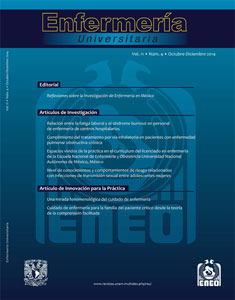Departamento de Enfermería, Facultad de Medicina, Universidad de Concepción, Concepción, Biobío, Chile
Main Article Content
Abstract
Objective: To identify the relationship between work fatigue and the Burnout syndrome among nursing staff (nurse and paramedical technicians) in two hospitals in southern Chile.
Methodology: An explanatory, correlational and cross-sectional study conducted in high-complexity hospital centers, with similar characteristics, in two representative southern Chile cities. The sample consisted of 101 nurses, 235 paramedic technicians, and 7 individuals who did not inform their title. The nursing staff had more than 2 years of working experience, worked full-time, and had defined or undefined contracts. The dependent variable is the Burnout syndrome, and the independent variables are the demographic and occupational factors, including fatigue. After obtaining the signed consent to participate, a tool was used that included sociodemographic and working variables (including the work family scale, the fatigue Check List Individual Strenght (CIS) scale, and the Maslach Burnout General Inventory Survey (MBIGS). The study was approved by the corresponding ethics committees.
Results: There was a high correlation between fatigue and Burnout syndrome, specifically with the emotional wear dimension (Rho = 0.680 P =.000) demonstrating that, when fatigues increases burnout also increases.
Conclusion: Attention needs to paid to the presence of fatigue among nursing staff, as this can be a sign of the development of Burnout syndrome. It is also necessary to assess each healthcare center according to its particular characteristics.
Publication Facts
Reviewer profiles N/A
Author statements
- Academic society
- N/A
- Publisher
- Universidad Nacional Autónoma de México
Article Details
Dimensions citation
MÉTRICAS
Enfermería Universitaria by Universidad Nacional Autónoma de México it is distributed under the License Creative Commons Attribution - NonCommercial - NoDerivatives 4.0 International
Accepted and published articles become open-access under the terms of the Creative Commons CC BY-NC-ND 4.0 license, which authorizes the reproduction and sharing without commercial purposes, provided the corresponding acknowledgments to their authors. Authors are allowed to manage a self-archive copy of the article’s published version so that they can open-access it in their personal or institutional web pages, and/or any other broad-diffusion space.


